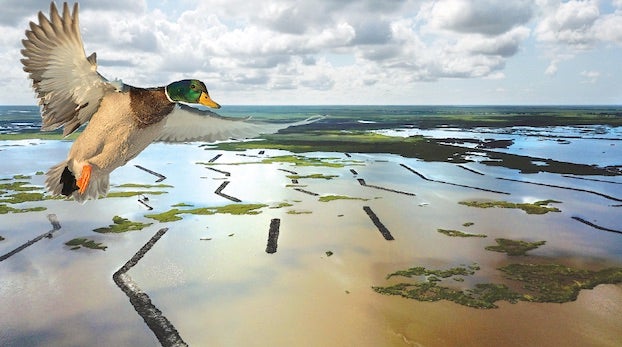Ducks Unlimited on a mission to preserve waterfowl habitat
Published 7:27 pm Monday, August 28, 2023

- The goal of the recently-created Creole Marsh Project is to regulate fresh water that “dabbling ducks” prefer and facilitate proper salinity levels for approximately 15,000 acres of coastal wetlands near Creole. (Special to the American Press)
Ducks Unlimited was built to advocate for and protect the habitats that houses North American’s waterfowl over 80 years ago, and they have no plan to stop, especially in Cameron Parish.
As the parish with the largest amount of land, Cameron Parish offers an abundance of wildlife and natural beauty within its marshlands for humans and waterfowl alike.
Ducks Unlimited’s conservation efforts date back to 1937. Over the last 86 years, DU has worked to conserve, restore and manage wetlands and other habitats that are the home to several species of waterfowl, Cassidy Lejeune, Ducks Unlimited director of conservation programs for south Louisiana said.
“The mission of Ducks Unlimited has stayed the same since its founding: filling the skies with waterfowl today, tomorrow and forever.”
They are able to accomplish this mission through “diverse partnerships” with state and governmental agencies, private partners, foundation and “the support of thousands of DU volunteers nationwide.”
Over 16 million acres of habitat for waterfowl have been conserved through DU’s efforts, with 240,000 of those acres conserved in Cameron Parish.
Lejeune explained that Cameron has been a priority, as it provides habitats for millions of waterfowl in winter. Additionally, the parish is known as one of the most important places in the United States for waterfowl hunting, ranking in the top five in waterfowl harvest.
One recent project was the Creole Marsh Project. The effort aimed to regulate fresh water that “dabbling ducks” prefer and facilitate proper salinity levels for approximately 15,000 acres of coastal wetlands near Creole. This regulation not only provides a comfortable environment for waterfowl, but also reduces impacts and land loss caused by saltwater intrusion, which are “necessary to maintain healthy marsh conditions.”
This has been a priority project for the Cameron Parish Gravity Drainage District 4 for decades, he said.
Projects like this are vital for the entire ecosystem of a wetland, he said. They provide habitat for over 900 species of fish and wildlife. The Creole Marsh Project specifically aids shorebirds, wading birds, fish, shrimp crabs and alligators alongside the species of waterfowl that are benefited – Gadwall, mottled ducks, blue-winged and American Green Wing Teal, Northern Pintail, Mallard, Norther Shoveler, Lessor Scaup to name a few.
“Cameron Parish has some of the most biologically diverse wildlife areas in the nation. This is why we work hard to protect what we love to ensure it remains for many, many decades to come.”
Humans also reap the benefits of healthy wetlands. Lejeune stated that the project will not only provide citizens with cleaner water and recreational opportunities, but will mitigate storm damages, reduce storm surge and protect “critical oil and gas infrastructure.”
The Creole Marsh project was completed in two phases.
The first step was to retrofit an existing concrete box culvert water control structure and install a new three-barrel aluminum culvert water control structure near Oak Grove. A large concrete box structure at Kings Bayou near the Mermentau River was retrofitted during phase two.
It took about two and a half years to complete, totaling $1,084,426. Lejune stated most funding came from a North American Wetlands Conservation Act (NAWCA) grant. These matching federal grants are provided by the U.S. Fish and Wildlife Service (FWS) to support public-private partnerships working on projects that involve “long-term protection, restoration and/or enhancement of wetlands,” according to FWS.
DU and the Cameron Parish Gravity Drainage District 4 contributed financially alongside private partnerships with Acadian Companies, Chevron and Lamar Advertising.
Post-project, a second structure was installed at Kings Bayou to add water management capacity. This addition used separate funding.
DU worked alongside several entities to complete the Creole Marsh Project, including the Cameron Parish Police Jury, the parish drainage district, Louisiana Coastal Protection and Restoration Authority, Coastal Impact Assistance Program Chevron and Phillips 66, he said.
Further Projects
The Creole Marsh Project is only one of 90 that have taken place in Cameron Parish. Through the combined efforts of DU’s biologists and engineers to design and execute projects to protect critical habitats and enhance Louisiana’s coastal wetlands in Cameron Parish and across the state.
Last year, DU and Chevron worked to start up a water level management project within Rockefeller Wildlife Refuge. Together, they installed a 30 inch
hydraulic water pump system that allows for periodic drainage and efficient drawdown every few years.
Lejeune explained that this will promote the growth of annual vegetation that is forage for migratory waterfowl during the winter months and provides foraging areas for wading birds and shorebirds during low water and mudflat conditions.
Additionally, proper management of water levels can also promote the growth of submerged aquatic vegetation, which is beneficial to a variety of fish and wildlife.
To the northeast of the Rockefeller project, Ducks Unlimited is in the final stages of completing another project centered around water level management. Here, their efforts are focused on the Cameron Prairie National Wildlife Refuge.
The aim is to enhance 1,200 acres of shallow water to better facilitate habitat management for waterfowl, shorebirds and wading birds.
Partnership has led to out-of-the-box thinking regarding marshlands and water-control structures. The Rice Stewardship Partnership was established in 2013, and is a joint effort between DU and Chevron to optimize waterfowl habitats in the rice fields of Southwest Louisiana. This program helps farmers conserve soil, water and waterfowl habitat on active rice lands.
For the last ten years, the ongoing collaboration has not only supported rice producers in maximizing their farm’s efficiency, but has also created stronger bottom lines, reduced water usage and mitigated fertilizer runoff.
Lejune expressed the vital role of Chevron’s decade-long support in bringing projects to fruition, emphasizing that the preservation of waterfowl winter habitats significantly impacts outdoor recreational pursuits like hunting and fishing in Louisiana.
Since it’s launch, the Rice Stewardship Partnership has taken root in all six major rice producing states – Louisiana, Arkansas, California, Mississippi, Missouri and Texas.
Lejeune said the willingness of government agencies and corporations to come together to find solutions and preserve these biologically diverse wildlife areas gives him hope.
“I know the birds will keep coming to Cameron Parish, because we are thinking creatively, and have the right people, the right partners.”





